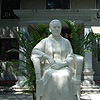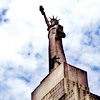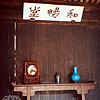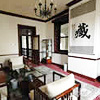On October 10, 1911, the Wuchang Uprising broke out. With one province after another declaring independence from the Qing Dynasty government. As a result, the rule of the Qing Dynasty collapsed, marking an end to the feudal autocratic monarchy of more than 2,000 years and founding the first republic in Chinese history.
To pay tribute to the 100th anniversary of the Chinese Revolution of 1911, with the guidance of Chinese Ministry of Culture, our team designed the photo album which is named "A Century of Change". Through the feature, we will share our insight from our hard work with the readers too.
Old Residence of Qiu Jin
The old residence of Qiu Jin is situated No 18 Hechangtang (a place of comfort) at the foot of Zhenta Hill in Shaoxing City, Zhejiang Province.
Qiu Jin (1879-1907), also known as Jianghu Nuxia (a heroine living near Mirror Lake), was a famous female revolutionary in modern China. Studying in Japan in 1904, she joined the Restoration Society, Chinese Revolutionary League and other democratic revolutionary organizations. In 1906, Qiu set up the China College and published the Chinese Women's Newspaper, which promoted Chinese women's rights, disseminated information about the revolution and engaged in anti-Qing activities. In 1907, she succeeded Xu Xilin to take charge of Datong School. Here Qiu came into contact with secret societies and the organization of the Restoration Army in preparation for the Anhui-Zhejiang anti-Qing armed uprising. In July of the same year, having failed in the uprising of Anqing, Anhui Province, Xu died a hero. Shortly afterwards, the Qing army besieged Datong School and Qiu was arrested. She died in the name of the revolution at the age of 28.
Qiu's old residence was originally part of a villa belonging to the Secretary of the Grand Council Zhu Geng of the Ming Dynasty (1368-1644). The residence has five rows of houses: the vestibule, Qiu's living quarters and three others where her mother and brothers lived. Qiu once received comrades in her chambers to secretly discuss the uprising. In the back wall of the living room is a secret chamber where arms and confidential documents were kept. The residence, which has been renovated many times, includes an exhibition room commemorating Qiu's historic accomplishments.
Editor: Shi Liwei
1、The Preparation of the Revolution
In November 1894, Sun Yat-sen setted up the Xingzhonghui in Honolulu. The next year in February, Sun built the headquarters of Xingzhonghui in Hongkong, and put forward the first guiding principle of the China democratic revolution.
2、The Uprising of the Revolution
The incompetent and corrupt rule of the Qing Dynasty caused extreme anger in Chinese people, finally, In June 1911, the Railway Protection Movement in Sichuan became the trigger of the Chinese Revolution of 1911.
3、The Success and Failure
December 1st, the Qing government signed the armistice with the revolutionary army, and the battle was stopped for three days. This truce is a key turning point that marks the revolution army changed the view from armed struggle to the politics of compromise.
4、Historic
The Chinese Revolution of 1911 is a great bourgeois-democratic revolution, which has far-reaching historic in modern Chinese history.




